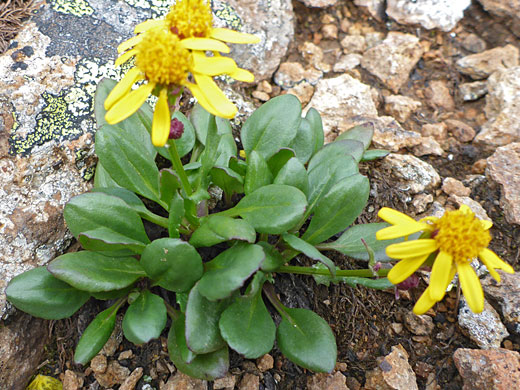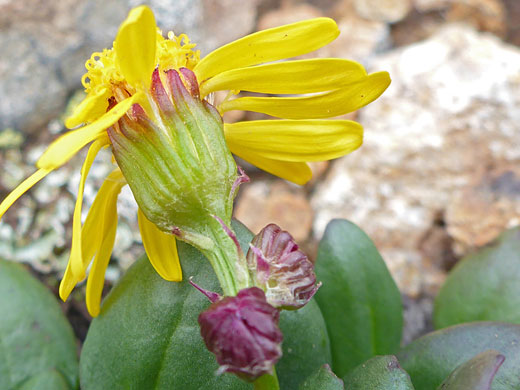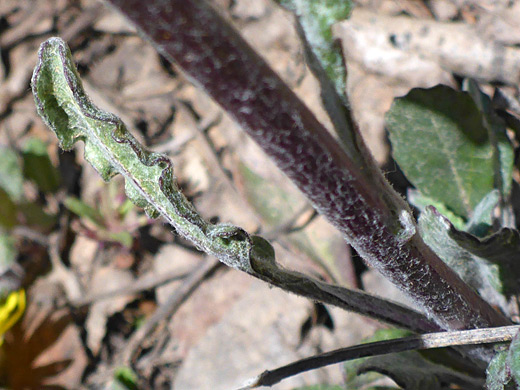Packera Dimorphophylla, Splitleaf Groundsel
Plants > Wildflowers > Asteraceae > Packera Dimorphophylla

Two yellow flowerheads of packera dimorphophylla, along the Porphyry Basin Trail, San Juan Mountains, Colorado
Common name:
Splitleaf groundsel
Family:
Scientific name:
Packera dimorphophylla
Main flower color:
Range:
The Rocky Mountain states, and small parts of Nevada and Oregon
Height:
Up to 12 inches
Habitat:
Moist meadows and hillsides, rocky slopes; 6,000 to 12,500 feet
Leaves:
Basal: stalked, round to ovate, quite thick, up to 2 inches long and 1.5 inches across. Stem leaves are sessile, and often lobed
Season:
July to August
The species name of packera dimorphophylla refers to the different forms of the leaves, at the base and along the stem. All leaves are bright green, hairless and quite thick; those at the base are attached via stalks, often winged, have edges either entire or shallowly toothed, and are variable in shape, from nearly round to ovate, lanceolate or reniform. In contrast, the few stem leaves are stalkless, and usually irregularly lobed. Upper stem leaves are bract-like, reduced in size. Plants usually produce one stem, sometimes two or three; they are covered in cobwebby hairs, as are the leaves and bracts.
Flowerheads form singly, or in small clusters (up to six). They have 8 or 13 yellow to orange ray florets, 45 to 60 yellow ray florets and 13 or 21 phyllaries. The phyllaries are equal in length, hairless, green towards the base and purple near the top. At the base of the involucre are several purple-tipped bractlets, the calyculi.
There are three varieties of packera dimorphophylla; most common is var dimorphophylla, which has conspicuously winged basal leaf stalks, gradually tapering basal leaf bases, and unbranched stems. This is found in high elevation meadows and slopes, above 9,000 feet. The other two, both uncommon, have leaf stalks lacking prominent wings, and variously shaped leaf bases (not smoothly tapering): var intermedia and var paysonii.
Flowerheads form singly, or in small clusters (up to six). They have 8 or 13 yellow to orange ray florets, 45 to 60 yellow ray florets and 13 or 21 phyllaries. The phyllaries are equal in length, hairless, green towards the base and purple near the top. At the base of the involucre are several purple-tipped bractlets, the calyculi.
There are three varieties of packera dimorphophylla; most common is var dimorphophylla, which has conspicuously winged basal leaf stalks, gradually tapering basal leaf bases, and unbranched stems. This is found in high elevation meadows and slopes, above 9,000 feet. The other two, both uncommon, have leaf stalks lacking prominent wings, and variously shaped leaf bases (not smoothly tapering): var intermedia and var paysonii.
All Contents © Copyright The American Southwest | Comments and Questions | Contribute | Site Map







